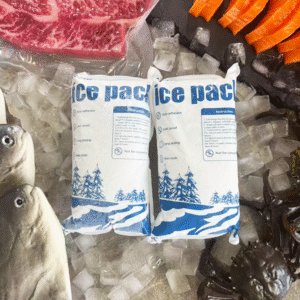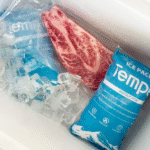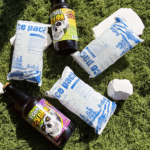Comment emballer correctement les aliments surgelés avec de la glace sèche: UN 2025 Guide
Emballer des aliments surgelés avec de la neige carbonique correctement est crucial pour garantir que vos produits restent congelés pendant le transport tout en respectant les règles de sécurité.. Dans ce guide, vous trouverez une description étape par étape du processus, les meilleurs matériaux d'emballage, calculs de glace carbonique, Précautions de sécurité, et comment rester en conformité avec 2025 règlements. Gardez vos expéditions dans des conditions optimales et répondez à toutes les exigences des transporteurs et des réglementations..
-
Comment calculer la quantité correcte de neige carbonique pour un emballage sûr
-
Meilleures méthodes d’emballage et d’isolation pour éviter la sublimation
-
Règles d'étiquetage clés et étapes de conformité pour éviter des erreurs coûteuses
-
Comment 2025 les innovations technologiques en matière de chaîne du froid peuvent rendre vos expéditions plus intelligentes et plus écologiques
Quelle quantité de glace carbonique devriez-vous utiliser pour emballer des aliments surgelés?
Réponse de base:
La quantité de neige carbonique nécessaire dépend de plusieurs facteurs: le poids du produit, la durée du transit, Et la température ambiante. Une règle générale est de planifier 5–10 lb de glace carbonique par 24 heures de transit pour chaque 10-15 livres de nourriture surgelée. Si le colis est mal isolé ou si l'environnement est plus chaud, Vous pourriez avoir besoin de plus.
Exemple de calcul de glace carbonique
Pour un 2-transit de jour avec 5 kg (11 lbs) de nourriture surgelée:
Glace sèche (lbs) = Poids du produit (kg) × 1.1 × Jours de transit × Tampon de sécurité
= 5 kg × 1.1 × 2 jours × 1.15 = 12.7 lbs de glace sèche.
Explication & Aperçu:
Glace sèche sublimate (passe du solide au gaz), ce qui signifie qu'il perd progressivement de la masse avec le temps. Meilleure est votre isolation et plus la température ambiante est basse, plus la sublimation est lente. Tenez toujours compte d'un marge de sécurité pour tenir compte des retards ou des inefficacités de l'isolation.
| Poids du produit | Temps de transit | Glace carbonique requise | Avantage |
|---|---|---|---|
| 5 kg | 2 jours | 12.7 lbs | Conserve les produits congelés avec un tampon pour retarder |
| 2 kg | 1 jour | 3–4 livres | Maintient un gel solide même avec un délai de 8 heures |
| 5 kg | 2 jours + tampon | 14–15 livres | Couvre les pics de température inattendus |
Quelles méthodes d'emballage et de ventilation garantissent une expédition sûre?
Réponse de base:
Pour la meilleure expédition de glace carbonique, Utiliser un système d'isolation multicouche avec une ventilation appropriée. La boîte extérieure doit être rigide (carton ondulé ou panneau de fibres), et l'isolation intérieure doit être constituée de Mousse EPS (polystyrène élargi) ou VIP (panneaux isolés sous vide). Ne fermez jamais l’emballage hermétiquement, car la neige carbonique génère du gaz, qui doit s'échapper pour éviter la montée en pression.
Conseils de ventilation et de distribution:
-
Ventilation:
Laissez de petits trous d'aération (autour 5–8 mm) pour que le gaz CO₂ s'échappe. Assurez-vous que la doublure est lâchement fermée mais pas scellée. -
Placement de la glace sèche:
Placez la glace carbonique sur le dessus et les côtés des aliments surgelés, pas en dessous, pour garantir que l'air froid coule correctement et entoure le produit. -
Vides et remplissage de l'espace:
Utiliser mousse, papier kraft, ou des coussins d'air pour combler les éventuelles lacunes à l'intérieur du colis. Cela réduit le flux d’air et aide à maintenir la température stable.
Exemple pratique:
Une entreprise de produits surgelés a optimisé son utilisation de glace carbonique en ajoutant isolation supplémentaire et repositionner la glace carbonique dans sacs perforés. Ils ont amélioré la durée de congélation de 15% et réduire les déchets en 10%.
Quelles sont les principales exigences en matière d'étiquetage et de documentation?
Réponse rapide:
Pour les expéditions d'air, la glace carbonique doit être étiquetée comme “Glace sèche / Dioxyde de carbone, Solide (UN1845)” avec poids net clairement marqué. Les expéditions contenant plus de 5.5 lbs (2.5 kg) de glace carbonique doit également inclure un Classe 9 Diamant de danger. Gardez toute la documentation à jour pour éviter les retards d'expédition.
Exigences spécifiques au transporteur:
-
UPS et FedEx:
Les deux nécessitent notation de la lettre de voiture (“Glace sèche, UN1845, poids net”) et un étiquetage approprié pour les marchandises dangereuses. -
Règles IATA et DOT:
Pour l'expédition internationale, se conformer à Voici pi 954 et Règlements DOT. Vérifiez toujours les limites spécifiques de chaque transporteur.
Pourquoi un étiquetage approprié est important:
Un étiquetage incorrect ou manquant peut entraîner des amendes coûteuses, retards, voire le rejet de votre envoi. UN Et 1845 étiquette garantit que votre glace carbonique est traitée comme une matière dangereuse conformément aux exigences légales.
Quelles sont les précautions de sécurité à prendre lors de la manipulation de glace carbonique?
Réponse de base:
La neige carbonique est dangereuse en raison de son froid extrême et du gaz CO₂ qu'elle libère en se sublimant.. Toujours porter gants isolés, lunettes, et vêtements de protection lors de la manipulation de glace carbonique, et assurez-vous que l'espace de travail est bien ventilé. Ne scellez jamais de glace carbonique dans des contenants hermétiques, car l'accumulation de gaz peut provoquer des explosions.
Meilleures pratiques de sécurité:
-
Utiliser un EPI (Équipement de protection individuelle):
Portez des gants isolants et des lunettes de protection à tout moment lorsque vous manipulez de la neige carbonique pour éviter les engelures ou les blessures dues à l'exposition au froid.. -
Ventilation:
Assurez-vous que toute manipulation de glace carbonique est effectuée des zones bien ventilées pour éviter l'accumulation de CO₂, ce qui peut déplacer l’oxygène et provoquer une asphyxie. -
Disposition appropriée:
Laisser la neige carbonique se sublimer dans un espace extérieur bien aéré. Ne jetez jamais de glace carbonique dans les égouts et ne la scellez jamais dans des conteneurs..
Exemple du monde réel:
Une entreprise de logistique alimentaire avait un 30% réduction des blessures liées à la manutention après avoir mis en œuvre des règles strictes formation à la sécurité et protocoles de ventilation.
Comment gérer les innovations de 2025 en matière de transport sous chaîne du froid?
Aperçu de la tendance:
À mesure que la technologie progresse dans 2025, des solutions plus intelligentes pour la chaîne du froid font leur apparition. Cela comprend Dosage du liquide de refroidissement piloté par l'IA, systèmes d'emballage intelligents qui suit la température en temps réel, et doublures écologiques qui contribuent à réduire l’impact environnemental.
2025 Innovations:
-
Gestion de la température pilotée par l'IA: Prédit les taux de sublimation et ajuste les quantités de neige carbonique en conséquence.
-
Emballage intelligent: Des capteurs intégrés suivent la température, assurer une surveillance constante pendant le transport.
-
Matériaux durables: Utilisation de isolation biodégradable et glace carbonique neutre en carbone est en augmentation, Réduire les déchets et les empreintes de pas carbone.
Perspicacité du marché:
Avec l’augmentation des expéditions de produits surgelés par le commerce électronique, les clients attendent fusion nulle livraisons. Les prestataires de la chaîne du froid adoptent de plus en plus ces innovations pour améliorer le contrôle de la température, réduire les déchets, et rencontrer objectifs de durabilité.
Questions fréquemment posées
Q1: Combien de temps dure la glace carbonique pendant le transport?
La glace carbonique peut durer 24–72 heures en fonction de l'isolation et du montant utilisés. Ajoutez toujours un supplément pour le temps tampon.
Q2: Puis-je expédier de la neige carbonique dans mes bagages personnels?
Oui, mais seulement jusqu'à 2.5 kg (5.5 lbs) avec l'accord préalable de la compagnie aérienne. Assurez-vous que le sac est ventilé et correctement marqué.
Q3: Comment calculer la glace carbonique pour mon envoi?
Utilisez la formule:
Glace sèche (lbs) = Poids du produit (lbs) × 1.1 × jours de transit × 1.15 tampon de sécurité.
Résumé et recommandations
Pour emballer correctement les aliments surgelés avec de la neige carbonique, calculez toujours la bonne quantité de neige carbonique, choisir un emballage approprié, et assurer un étiquetage approprié. Pour 2025, adopter plus intelligemment, des technologies plus durables amélioreront l’efficacité et la conformité. Faites de la sécurité une priorité en suivant les meilleures pratiques en matière de manipulation et d'évacuation de la neige carbonique..
Étapes suivantes:
-
Révisez vos méthodes d'emballage et intégrez des emballages intelligents ou alimentés par l'IA pour une meilleure surveillance de la température..
-
Mettez à jour votre Sops avec 2025 lignes directrices et organiser des séances de formation sur la manipulation de la glace carbonique.
-
Assurer le respect de toutes les réglementations et exigences des transporteurs pour éviter les retards.
À propos du tempk
Et tempk, nous sommes spécialisés dans les solutions d'emballage pour chaîne du froid qui réduisent les déchets de glace carbonique jusqu'à 30% tout en maintenant la conformité et la performance. Nos conceptions sont adaptées pour répondre aux exigences strictes du transport aérien et terrestre dans 2025. Contactez-nous pour un consultation personnalisée pour optimiser vos expéditions.
























